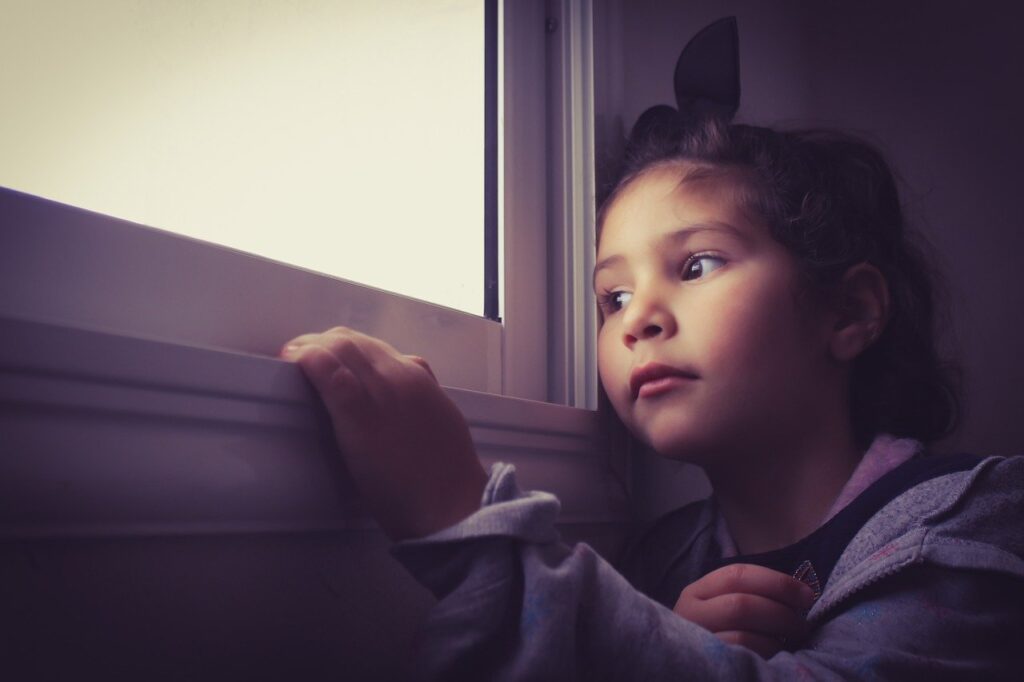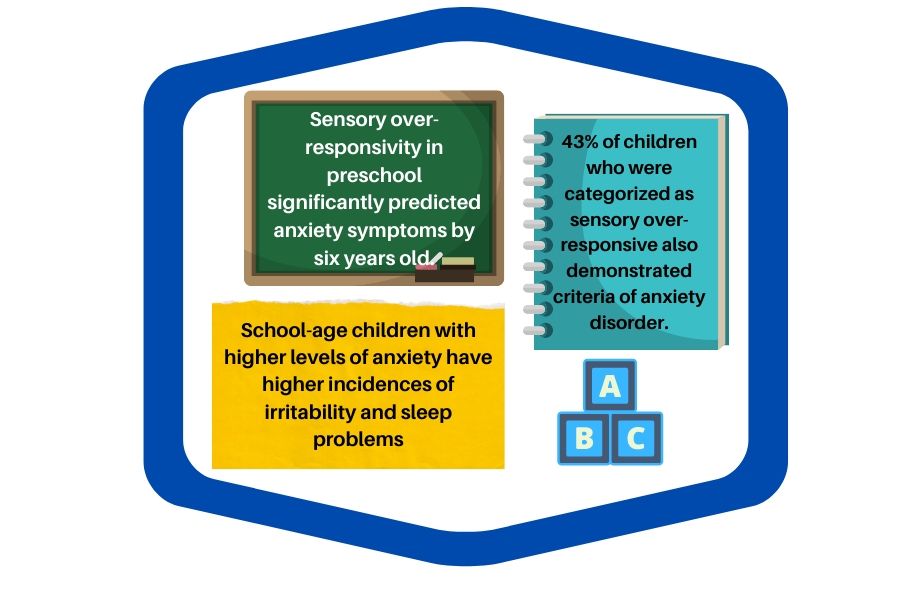
We’re all overly familiar with the phrase, “sensory or behavior,” but I think we may leave important factors out when we pit the two as an “or” situation as well as the connotation of what “behavior” means to us. Behavior, while simplified by an Antecedent, Behavior, Consequence model can seem straightforward, is often just the opposite.
What impacts a child’s behavior? So. many. things. We know that physiological factors like blood sugar and being tired impact it. We also know that emotional processing and patterns shaped by dynamics at home and with caregivers impacts it. Communication skills, especially an impairment of, guide behavior.
Today’s review explores a study that investigated the relationship between sensory processing and anxiety. A CuriosOT follower on Facebook requested that I explore this topic, and I was happy to do so as this is a topic I’ve wondered about myself in recent years.
In our busy society, I think we can see that more adults and children alike are presenting with mental health concerns. As an OT I know that I have seen kids who may have sensory issues, but definitely have anxiety. Other times I’ve seen children who seem to me that they obviously have anxiety, and I’m not sure if sensory processing is contributing to their challenges in occupational performance.
So, are sensory processing and anxiety related? Either way, what is OT’s role in treatment when we receive a child who has one or both of these diagnoses? Today’s post will cover the relationship between sensory processing and anxiety, and my next post will cover what is OT’s role.
Journal Journal of Abnormal Child Psychology (SNIP score 1.759)
Article Title Sensory Over-Responsivity: An Early Risk Factor for Anxiety and Behavioral Challenges in Young Children
Level of Evidence
- 1A Systematic review of homogenous RCTs
- 1 B Well-designed individual RCT
- 2A Systematic review of cohort studies
- 2B Individual prospective cohort study, low quality RCT, ecological studies; and two-group, non-randomized studies
- 3A Systematic review of case control studies
- 3B Individual retrospective case-control studies; one-group, non-randomized pre-post test study; cohort studies
- 4 Case series (and low-quality cohort and case control study)
- 5 Expert opinion without explicit critical appraisal
Methods
The study authors obtained their baseline sample from the larger sample of the Duke Preschool Anxiety Study. That study had three parts: screening, in-home assessment and a laboratory phase (Carpenter et al., 2018, p. 4). The sample from the Duke Anxiety studied was obtained by screening children between 2-5 years old during visits to their primary care clinics. The sample was found to be representative of the general population.
Authors of the Duke Anxiety study invited the children who met criteria for generalized anxiety disorder (GAD), separation anxiety disorder (SAD) and/or social phobia to participate in the Phase 3 laboratory assessment (Carpenter et al., 2018, p. 4). Authors of the current study recruited children from this phase 3 to participate in the Learning About the Developing Brain (LABD) study. This was a five year study in which researchers followed a group of 191 children to assess relationships between sensory processing during preschool years and anxiety during school-age years.
Assessments
Study authors used the Preschool Age Psychiatric Assessment to assess anxiety and sensory over responsivity characteristics. Parents completed interviews to assess for symptoms of a variety of psychiatric disorders for children of preschool age. Parents of 191 children completed this assessment when their child was in preschool and age at school-age.
Anxiety
Researchers classified children as either meeting impairment and symptom criteria for the included anxiety disorders (GAD, SAD and/or social phobia) or not meeting those criteria. Children were identified as positive on the anxiety screening if their parent included at least 4 of 10 items on the screening tool.
Sensory Over-Responsivity
Researchers used the PAPA at baseline and follow-up to assess sensory over-responsivity. Responses to the following sensory experiences were accounted for: 1. physical contact with other people 2. Contact with fabrics, clothes tags, etc. 3. Contact with food textures 3. Visual experiences 5. Auditory experiences, including loud or high-pitched noises 7. Olfactory experiences 7. Tastes 8. Sensations of motion 9. Any other sensory experiences.
Behavioral Challenges
This study highlighted sleep problems, GI problems, food selectivity and irritability as related behavioral challenges.
Findings
Sensory Over-responsivity is not Uncommon for Preschool Children
Twenty percent of parents reported at least one sensory domain as over-responsive from the pre-school sample (Carpenter et al., 2018, p. 8). The most commonly rated areas were tactile (18%) and auditory (4%). Children with sensory over-responsivity at preschool who remained rated as such by school-age was 56%. Sixteen percent of children whose parents did not rate them as sensory over-responsive in preschool were rated as having sensory over-responsivity by school-age.
The proportion of females who parents described as sensory over-responsive was higher than the proportion of males who parents ranked as so (Carpenter et al., 2018, p. 8). Parents of children whose children were categorized as below the federal poverty line also were significantly ranked more often as sensory over-responsive.
Relationship Between Sensory Over-responsivity and Anxiety Disorders in the Preschool Sample
Researchers found a significant relationship between sensory over-responsivity and anxiety diagnoses in preschool, as 43% of children who were categorized as sensory over-responsive also demonstrated criteria of anxiety disorder. Researchers found that there was also a significant relationship between sensory over-responsivity and other disorders (i.e. ADHD) from the preschool sample (Carpenter et al., 2018, p. 9).
Did Sensory Over-responsivity in Preschool Predict Anxiety Symptoms by School-age?
The authors found that sensory over-responsivity in preschool significantly predicted anxiety symptoms by six years old. This stayed true when other potentially confounding variables (including sex, age, race, poverty status) were accounted for. This also remained true when the factors of a child having sensory over-responsivity by school age, anxiety symptoms when in preschool and a diagnosis of other disorders in preschool were accounted for. All this to say that potentially confounding factors assessed for in preschool did not otherwise explain the development of anxiety by school-age.

What Type of Anxiety Disorder Does Sensory Over-responsivity Predict?
The authors found sensory over-responsivity as a significant predictor only for generalized anxiety disorder, not separation anxiety disorder or social phobias.
Could Preschool Anxiety Cause School-age Sensory Over-responsivity?
A child having anxiety symptoms in preschool did not significantly predict a presence of sensory over-responsivity in school age children. When researchers assessed if preschool sensory over-responsivity predicted non-anxiety disorders for school age children, they found it did not. This indicates that preschool sensory over-responsivity is a significant predictor specifically of anxiety for school age children as opposed to a wide variety of non-anxiety disorders.
So What’s the Link Between Preschool Sensory Over-responsivity, School-age Anxiety and the Behavioral Challenges We See by School-age?
Researchers found a significant relationship between preschool children with higher levels of sensory over-responsivity showing higher levels of anxiety by school-age. They also noted that school-age children with higher levels of anxiety have higher incidences of irritability and sleep problems. Researchers did not find a significant relationship between the sensory and anxiety measures as they impacted GI symptoms or food selectivity by school age.
Things to Consider
The authors mention that they only collected data for two periods of time which is insufficient to completely achieve the ideal statistical criteria to state the impact sensory over-responsivity has on how anxiety and behavioral challenges manifest.
The authors also mentioned that to measure sensory over-responsivity they used an interview that was comprehensive and not specific to sensory over-responsivity. They feel it may be best to use a tool that specifically measures that.
Also of note is that the measures for anxiety and over-responsivity came exclusively from parent-report. It would be beneficial to have a second rater to corroborate these levels. They also mentioned that research has shown that sometimes a mother’s emotional symptoms impacts her rating of her child’s symptoms of mental health conditions.
The researchers would also like to assess how sensory under-responsivity and sensory seeking relate to anxiety.
What Do You Think?
How do you decide if a child presents with anxiety or sensory processing disorder? How would you use this information to guide your treatment?
References
Carpenter, K. L., Baranek, G. T., Copeland, W. E., Compton, S., Zucker, N., Dawson, G., & Egger, H. L. (2018). Sensory Over-Responsivity: An Early Risk Factor for Anxiety and Behavioral Challenges in Young Children. Journal of Abnormal Child Psychology, 47(6), 1075-1088. doi:10.1007/s10802-018-0502-y
